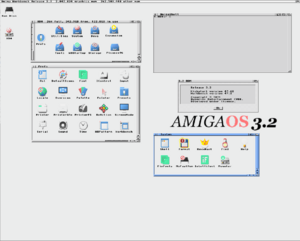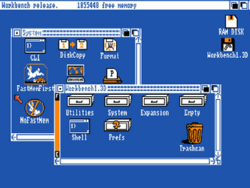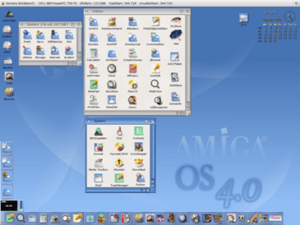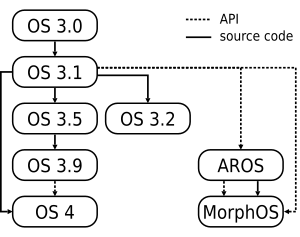AmigaOS facts for kids
 |
|

Screenshot of AmigaOS 3.2
|
|
| Company / developer |
|
|---|---|
| Programmed in | Assembly language, BCPL, C |
| OS family | Amiga |
| Working state | Current |
| Source model | Closed source |
| Initial release | July 23, 1985 |
| Latest stable release | 4.1 Final Edition Update 2 / January 12, 2021 |
| Supported platforms | M68K: versions 1.0 through 3.9 PowerPC: versions 4.0 through 4.1 |
| Kernel type | Microkernel |
| Default user interface | Graphical (Workbench) |
| License | Proprietary |
AmigaOS is a special type of operating system made for Amiga and AmigaOne computers. Think of an operating system as the main program that makes your computer work, like Windows or macOS. AmigaOS was first created by a company called Commodore International and came out in 1985 with the very first Amiga computer, the Amiga 1000.
Early versions of AmigaOS needed a specific type of computer chip called the Motorola 68000. After Commodore stopped making computers, other companies like Haage & Partner and Hyperion Entertainment continued to develop AmigaOS. Newer versions of AmigaOS need a different, more powerful chip called PowerPC.
AmigaOS is designed for one user at a time. It uses a special core program called Exec that lets the computer do many things at once without slowing down. It also includes a way to manage the computer's parts, a disk system called AmigaDOS, a way to create windows and menus called Intuition, and a desktop where you see your files and programs, called Workbench.
Today, there are other operating systems like MorphOS and AROS Research Operating System that work like AmigaOS and can run many of its programs.
Contents
Who Owns AmigaOS?
The rights to AmigaOS are split among a few companies: Amiga Inc., Cloanto (who makes Amiga Forever), and Hyperion Entertainment (who develops AmigaOS 4.x). Cloanto owns the rights to works created up to 1993.
In 2001, Amiga Inc. asked Hyperion Entertainment to develop AmigaOS 4. Later, in 2009, Hyperion was given a special, lasting license to AmigaOS 3.1. This allowed them to keep developing and selling AmigaOS 4 and future versions.
Different Types of AmigaOS
Since 2004, there have been two main types of AmigaOS that exist at the same time:
AmigaOS for PowerPC Computers
AmigaOS 4 and its updates (v4.x) were developed by Hyperion Entertainment. These versions are only for Amiga computers that have a PowerPC processor.
- Older Amiga computers with just faster versions of their original chips (Motorola m68k) cannot run AmigaOS 4. It needs a PowerPC chip to work.
- So, AmigaOS 4 works only on PowerPC computers.
AmigaOS for m68k Computers
The older versions of AmigaOS, up to AmigaOS v3.1, were made by Commodore. Later, Haage & Partner released AmigaOS 3.5 and 3.9. More recently, Hyperion Entertainment released updates like v3.1.4 and v3.2 for the original AmigaOS. These versions are for classic Amiga computers like the A1000, A500, A1200, and A4000, which use Motorola m68k processors.
- AmigaOS 3.5 and 3.9 needed at least a Motorola M68020 processor. This was found in computers like the Amiga A1200 or A3000.
- AmigaOS v3.1.4 (released in 2018) and v3.2 (released in 2021) are based on Commodore's original AmigaOS v3.1. These updates also came with new Kickstart ROMs, which are like the computer's basic startup instructions.
- These versions work on all m68k CPUs, even the very first MC68000 in the Amiga A1000.
How AmigaOS Works
AmigaOS is a single-user operating system. It uses a special core program called Exec that helps the computer do many tasks at once. AmigaOS helps programs talk to the computer's hardware. It has a disk system called AmigaDOS, a window system called Intuition, and a desktop called Workbench.
You can also use a text-based interface called AmigaShell, which is like a command prompt. Both the AmigaShell and Workbench have the same access to the system. One thing to note is that AmigaOS doesn't have built-in memory protection, which means programs can sometimes interfere with each other's memory.
AmigaOS has two main parts:
- Kickstart: This is like the computer's startup instructions, usually stored in a special memory chip (ROM). It helps the Amiga boot up and contains important parts of the operating system.
- Workbench: This is the software part you see, the desktop environment.
Until AmigaOS 3.1, Kickstart and Workbench were usually released together. After Commodore stopped, only the software part (Workbench) was updated. However, in 2018, Hyperion Entertainment released AmigaOS 3.1.4 with an updated Kickstart ROM.
Kickstart: The Startup Brain
Kickstart is the basic software that helps the Amiga computer start up. It's usually stored in a ROM chip. Kickstart has the code needed to boot the Amiga and many core parts of AmigaOS. It's similar to the BIOS in a PC, but Kickstart does more, like starting the full windowing environment right away.
Kickstart contains important parts of the Amiga's operating system, such as Exec, Intuition, and the core of AmigaDOS. It also helps the computer recognize new hardware you plug in. Later versions of Kickstart included drivers for hard drives and other built-in parts.
When you turn on or restart an Amiga, Kickstart checks the system, sets up the computer's chips, and then tries to start from a connected device, like a floppy disk or hard drive. If it can't find a boot device, it asks you to insert a disk.
Floppy disks often had a special "bootblock" that told the computer how to start. Some games and demos used their own bootblocks to take full control of the Amiga's hardware without AmigaOS. Unfortunately, this also made bootblocks a target for viruses.
Exec: The Multitasking Manager
Exec is the core part of AmigaOS that handles multitasking. This means it lets the computer run many programs at the same time, switching between them very quickly. Exec also manages memory, handles signals from hardware, and deals with shared program parts.
Exec acts like a traffic controller for programs, making sure they all get a turn to run. It also helps different programs talk to each other by sending messages. Because AmigaOS uses a single memory area, this message-sending is very fast.
AmigaDOS: The File Organizer
AmigaDOS is the part of AmigaOS that manages files and disks. It handles things like organizing files and folders, using the command line, and redirecting where information goes. It lets you use commands to manage your files and even create scripts (small programs) to automate tasks.
In early AmigaOS versions (1.x), AmigaDOS was based on a language called BCPL. From AmigaOS 2.x onwards, AmigaDOS was rewritten in C and Assembler, making it more efficient while still working with older programs.
In AmigaOS 4.0, AmigaDOS was completely rewritten. Starting with AmigaOS 4.1, it supports larger, 64-bit systems.
AmigaOS often uses file extensions (like .txt or .jpg), but they are not strictly required. The system recognizes executable programs by a special "magic number" inside the file.
Intuition: The Graphical Interface
The Amiga's main windowing system is called Intuition. It handles what you see on the screen, like windows, menus, and buttons, and takes input from your keyboard and mouse.
Before AmigaOS 2.0, programs often had their own unique look for buttons and menus. With AmigaOS 2.0, Commodore added GadTools library and BOOPSI, which provided standard ways to create these elements. They also published a guide to help developers make programs look consistent.
A cool feature of AmigaOS is that you can have multiple "screens" on the same display. Each screen can have a different resolution or number of colors. AmigaOS 2.0 allowed programs to open windows on other programs' screens. You can switch between screens by clicking a small button in the top-right corner.
Workbench: The Desktop Manager
Workbench is the graphical file manager and desktop environment of AmigaOS. It's like your computer's desktop where you see icons and open programs. The name "Workbench" suggests a workspace, not just a desk. Folders are called drawers, programs are tools, data files are projects, and buttons are gadgets.
The Workbench desktop shows icons for disks and hard drive parts, and there's a single menu bar at the top of every screen. The standard Amiga mouse has two buttons: the right button is used for pull-down menus.
Cool Features of AmigaOS
Graphics Capabilities
Until AmigaOS 3, the system mostly supported the Amiga's own graphics chips. Later, a system called retargetable graphics (RTG) allowed AmigaOS to support other graphics cards. With AmigaOS 3.5, some RTG systems were included, letting users use common graphics cards.
The Amiga didn't have built-in 3D graphics, but it became a popular platform for 3D development. Many important 3D software programs, like Imagine, Cinema 4D, and Lightwave (used for TV shows like Babylon 5), were developed on the Amiga.
The Amiga was also known for its ability to easily connect with video equipment. Many third-party devices allowed users to capture video frames. Modern AmigaOS 4.1 uses advanced 3D graphics features for its interface.
Audio Features
Before version 3.5, AmigaOS only supported the Amiga's built-in sound chip, which had four sound channels. Later, a standard called AHI was created, allowing support for third-party audio cards and better sound features like mixing multiple sound channels.
AmigaOS didn't support MIDI (for electronic music instruments) until version 3.1.
One unique feature of AmigaOS was its speech synthesis system, developed by SoftVoice, Inc. This allowed the computer to read out text in American English. It had parts that changed text into sounds and a "SPEAK:" command that let users hear text. A program called Say was included, and some word processors could even read documents aloud. This feature was later removed from AmigaOS 2.1 due to licensing issues.
Storage Options
AmigaOS has a special RAM disk that automatically changes size to fit its contents. Starting with AmigaOS 2.x, important system files were loaded into this RAM disk when the computer started, making it much faster to use. You could also copy other files to the RAM disk for quick access.
From AmigaOS 1.3, there was also a fixed-size RAM disk that could keep its contents even after a soft restart. This was often called the RAD disk.
Scripting with ARexx
AmigaOS supports a powerful scripting language called ARexx. It's like a programming language that lets you automate tasks across the entire operating system. You can use it to control different programs and even make them talk to each other.
For example, an ARexx script could tell an email program to save an email, then send it to another program to process information, and finally open a viewer program. This makes it easy for programs to work together.
Since AmigaOS 4, the Python language is also included with the operating system.
Technical Details
In 1996, tech writer John C. Dvorak said that AmigaOS was "one of the great operating systems of the past 20 years." He praised its small size and amazing multitasking abilities, which were only recently seen in other systems like OS/2 and Windows NT. He noted that AmigaOS could multitask fully in very little memory (as little as 250 KB) and that even today, the OS is only about 1 MB. He called it "tight code" and mentioned how reliable Amiga computers were.
Libraries and Devices
AmigaOS uses a modular system, meaning its functions are split into different parts called libraries. These libraries are loaded when needed and can be found as files with a "`.library`" extension or stored in the Kickstart firmware. This design allows parts of the system to be updated or changed easily.
Device drivers are also libraries, but they have a special way of working. Programs usually don't talk directly to devices but use the exec.library to access them. Like libraries, devices can be files (with a "`.device`" extension) or in the Kickstart ROM.
Handlers, AmigaDOS, and Filesystems
Higher-level management of devices and resources is done by handlers. These are like small programs that communicate by sending messages. One type of handler is a filesystem handler, which lets AmigaOS use different ways to organize files on disks. This allowed programs like CrossDOS to read PC disks and also led to new file systems with features like journaling (which helps prevent data loss).
Handlers often create a "device name" that you can use to access a device. For example, DF0: usually means the first floppy drive. Hard drives might be DH0:. Filesystems also have "volume names," like Workbench: if your disk is named "Workbench."
Programs often need to find files without knowing their exact location. This is solved by assigns. An assign is like a shortcut that points to a directory. For example, SYS: points to the main directory of your boot drive. Other common assigns include:
- C: for shell commands.
- DEVS: for system devices.
- LIBS: for system libraries.
- S: for scripts, like the `startup-sequence` that runs when the computer boots.
- T: for temporary files.
- PROGDIR: (introduced in Workbench 2.0) points to the folder where the program you're currently running is located.
Memory Management in Later Versions
AmigaOS 4 brought new ways to manage computer memory (RAM) and keep it organized. It also introduced a "memory pager" that helps move parts of memory to mass storage devices, acting like a type of virtual memory. This means the computer can use hard drive space as if it were extra RAM.
AmigaOS Versions Over Time
Since AmigaOS started in 1985, there have been several major updates. Until version 3.1, Commodore called the entire operating system "Workbench." So, "Workbench" often meant both the OS and the desktop manager. From version 3.5, the OS was officially renamed "AmigaOS," and "Workbench" only referred to the desktop.
Workbench always allowed users to customize its look. You could change icons, their size, and even make them look animated. You could also save how your icons and windows were arranged on the desktop.
AmigaOS 1.0 – 1.4
AmigaOS 1.0 came out with the Amiga 1000 in 1985. The 1.x versions usually had a blue and orange color scheme, which was good for old TV screens. Users could change the colors. Version 1.1 mostly fixed bugs.
You could customize the display a lot for that time. Users could create their own icons, change four display colors, and choose from different resolutions. Some features, like a "gauge-meter" for free disk space, were changed in later versions.
AmigaOS 2.0, 2.1
AmigaOS 2.0 was released with the Amiga 3000 in 1990. Before this, programs often had their own unique buttons and menus. With AmigaOS 2.0, gadtools.library was created, providing standard ways to make these elements. This helped programs look more consistent.
AmigaOS 2.0 also added "public screens," allowing programs to share their screens with other applications. It also improved how programs handled keyboard and mouse input, preventing them from freezing the system.
AmigaOS 2.1 introduced AmigaGuide, a simple system for online help within programs. It also brought Installer, a standard program for installing software. This version also added support for different languages.
AmigaOS 3.0, 3.1
Versions 3.0 and 3.1 came with the Amiga 1200 and Amiga 4000 computers. Version 3.0 added "datatypes" support. This meant that if a program supported datatypes, it could open any file format that had a datatype installed. For example, Workbench could show any image as a background if the right datatype was there. A small program called Multiview could open and display any supported file.
In December 2015, the AmigaOS 3.1 source code became public online.
AmigaOS 3.5, 3.9
About six years after AmigaOS 3.1, Haage & Partner updated AmigaOS. These versions (3.5 in 1999 and 3.9 in 2000) were software-only updates for existing systems with at least a 68020 processor.
The look of AmigaOS was updated with better icons and support for true color backgrounds. These versions included support for popular third-party improvements like NewIcons. AmigaOS 3.5 and 3.9 came with new 256-color icons and desktop wallpapers, replacing the older gray look.
AmigaOS 3.9 added a program start bar called AmiDock and improved system settings.
AmigaOS 3.1.4, 3.2
In September 2018, Hyperion Entertainment released AmigaOS v3.1.4. This was both a software and hardware update for classic Amigas, including updated Kickstart ROMs that users could install.
AmigaOS v3.1.4 was meant to fix bugs but also updated many parts of the system that were improved in OS 3.9. It included fixes, support for larger hard drives (even at boot-up), and worked with all Motorola 680x0 CPUs, including the 68060. It also had a modernized Workbench with new icons. Unlike AmigaOS 3.5/3.9, AmigaOS 3.1.4 still supported the original Motorola 68000 CPU.
Hyperion also added many features from Haage & Partner's Amiga 3.5 and 3.9, such as support for long file names and updated disk integration. AmigaOS v3.1.4 also came with newer Kickstart ROMs.
In 2019, AmigaOS 3.1.4.1 was released as a free software update to fix bugs. In May 2021, Hyperion Entertainment released AmigaOS 3.2, which included all features of 3.1.4.1 and added new improvements like support for ReAction GUI, managing Amiga Disk File images, an integrated help system, and improved datatypes. Updates 3.2.1 (December 2021) and 3.2.2 (March 2023) brought more bug fixes and improvements.
AmigaOS 4.0, 4.1
This newer AmigaOS, called AmigaOS 4.0, was completely rewritten to work with PowerPC processors. It was a big step to make it work independently of the old Amiga chips. In AmigaOS 4.0, screens could be dragged in any direction, and you could drag and drop icons between different screens.
AmigaOS 4.0 also included a new version of Amidock, TrueType/OpenType fonts, and a movie player that supported DivX and MPEG-4.
AmigaOS 4.1 added new startup preferences, updated icons for higher screen resolutions, new window themes, and an updated AmiDock with transparency and scalable icons. It also gained an auto-update feature.
In October 2022, Hyperion Entertainment released a special kit for developers to create programs for AmigaOS 4.1.
How AmigaOS Inspired Other Systems
- AROS Research Operating System (AROS) is an open-source operating system that works like AmigaOS. It's not exactly the same, but many AmigaOS programs can run on it.
- MorphOS is another operating system for PowerPC computers, including some Amiga hardware. It works like AmigaOS and can run many AmigaOS programs.
- pOS was a closed-source operating system that aimed to be compatible with Amiga software.
- BeOS had a similar way of handling different file types (like text, music, videos) to AmigaOS. This was because old Amiga developers asked Be to use a similar system.
- AtheOS was inspired by AmigaOS and originally meant to be a copy of it. Syllable is a newer operating system that came from AtheOS and has some features like AmigaOS.
- FriendUP is a cloud-based operating system with many former Commodore and Amiga developers working on it. It has several features similar to AmigaOS, like DOS Drivers and screen dragging.
- The operating system for the 3DO Interactive Multiplayer game console looked very much like AmigaOS. It was developed by RJ Mical, who also created the Amiga's Intuition user interface.
See also
 In Spanish: AmigaOS para niños
In Spanish: AmigaOS para niños
- Comparison of operating systems




